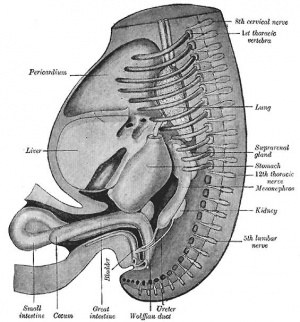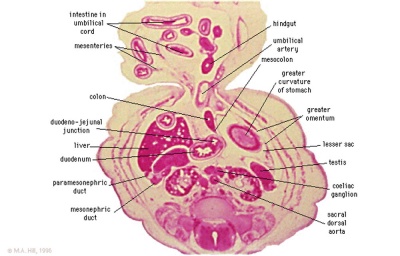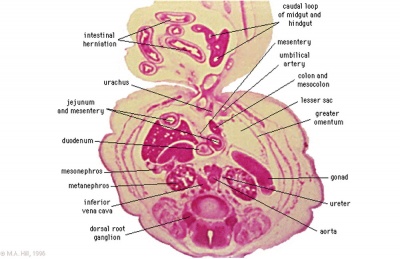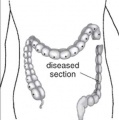Gastrointestinal Tract - Intestine Development: Difference between revisions
No edit summary |
|||
| Line 4: | Line 4: | ||
==Introduction== | ==Introduction== | ||
[[File:Gray0986.jpg|thumb|midgut herniation]] | [[File:Gray0986.jpg|thumb|midgut herniation]] | ||
The part of the gastrointestinal tract (GIT) lying between the stomach and anus, is described as the '''intestines''' or '''bowel'''. This region is further divided anatomically and functionally into the small intestine or bowel (duodenum, jejunum and ileum) and large intestine or bowel (cecum and colon). | The part of the gastrointestinal tract (GIT) lying between the stomach and anus, is described as the '''intestines''' or '''bowel'''. This region is further divided anatomically and functionally into the small intestine or bowel (duodenum, jejunum and ileum) and large intestine or bowel (cecum and colon). Initially development concerns the midgut region, connected to the yolk sac, and the hindgut region, ending at the cloacal membrane. This is followed by two mechanical processes of elongation and rotation. Elongation, growth in length, leaves the midgut "herniated" at the umbilicus and external to the abdomen. Rotation, around a mesentery axis, establishes the anatomical position of the large intestine within the peritoneal space. | ||
[[File:GIT- Jejunum 01.jpg|thumb|Jejunum histology]] | [[File:GIT- Jejunum 01.jpg|thumb|Jejunum histology]] | ||
:{{Template:Gastrointestinal Tract Links}} | :{{Template:Gastrointestinal Tract Links}} | ||
Revision as of 11:23, 30 April 2011
Introduction
The part of the gastrointestinal tract (GIT) lying between the stomach and anus, is described as the intestines or bowel. This region is further divided anatomically and functionally into the small intestine or bowel (duodenum, jejunum and ileum) and large intestine or bowel (cecum and colon). Initially development concerns the midgut region, connected to the yolk sac, and the hindgut region, ending at the cloacal membrane. This is followed by two mechanical processes of elongation and rotation. Elongation, growth in length, leaves the midgut "herniated" at the umbilicus and external to the abdomen. Rotation, around a mesentery axis, establishes the anatomical position of the large intestine within the peritoneal space.
Embryonic Development
Week 4
| Quicktime | Flash |
Week 8
Late embryonic small intestine commencing at the duodenum, continuing as ventrally herniated and returning to join the colon.
Molecular Factors
- Cdx (Caudal-type homeobox) group of ParaHox genes (mouse Cdx1, Cdx2 and Cdx4)[1]
Abnormalities
References
- ↑ <pubmed>20298182</pubmed>
Reviews
Articles
Search Pubmed
Search Bookshelf Intestine Development
Search Pubmed Now: Intestine Embryology | Intestine Development
Glossary Links
- Glossary: A | B | C | D | E | F | G | H | I | J | K | L | M | N | O | P | Q | R | S | T | U | V | W | X | Y | Z | Numbers | Symbols | Term Link
Cite this page: Hill, M.A. (2024, May 18) Embryology Gastrointestinal Tract - Intestine Development. Retrieved from https://embryology.med.unsw.edu.au/embryology/index.php/Gastrointestinal_Tract_-_Intestine_Development
- © Dr Mark Hill 2024, UNSW Embryology ISBN: 978 0 7334 2609 4 - UNSW CRICOS Provider Code No. 00098G











